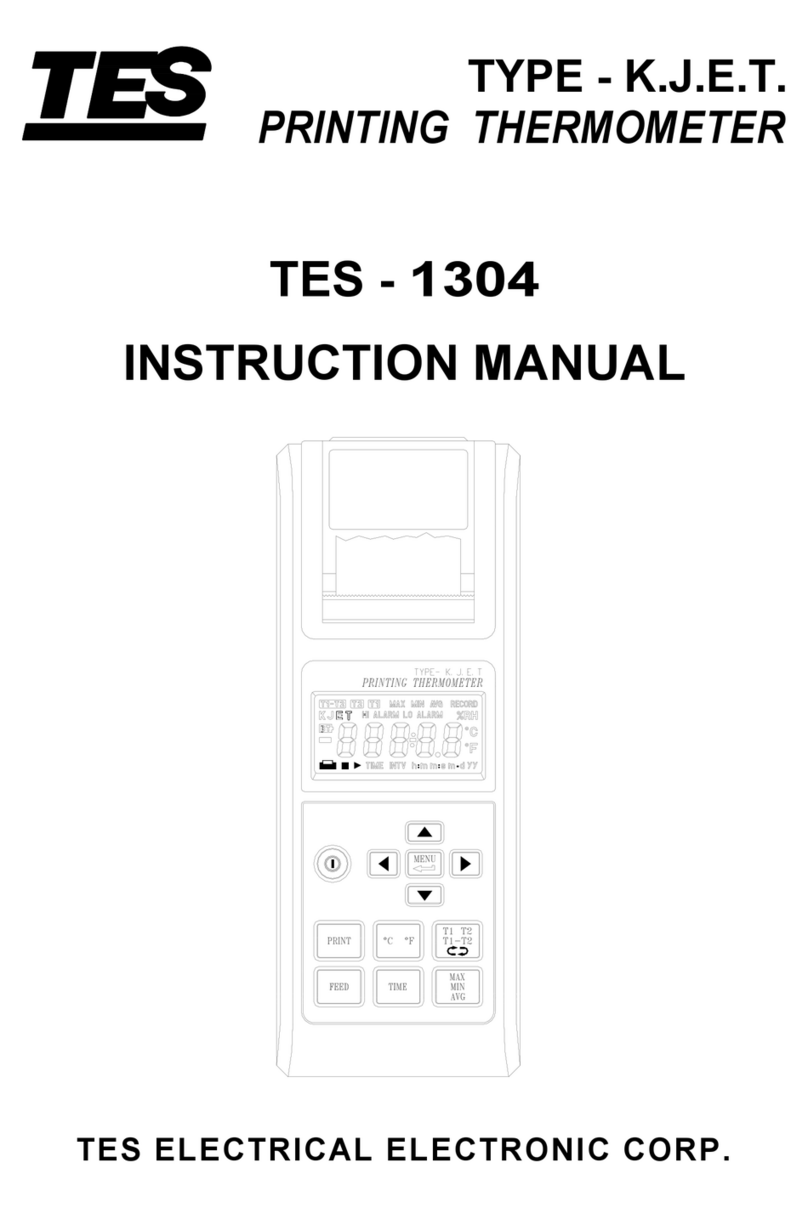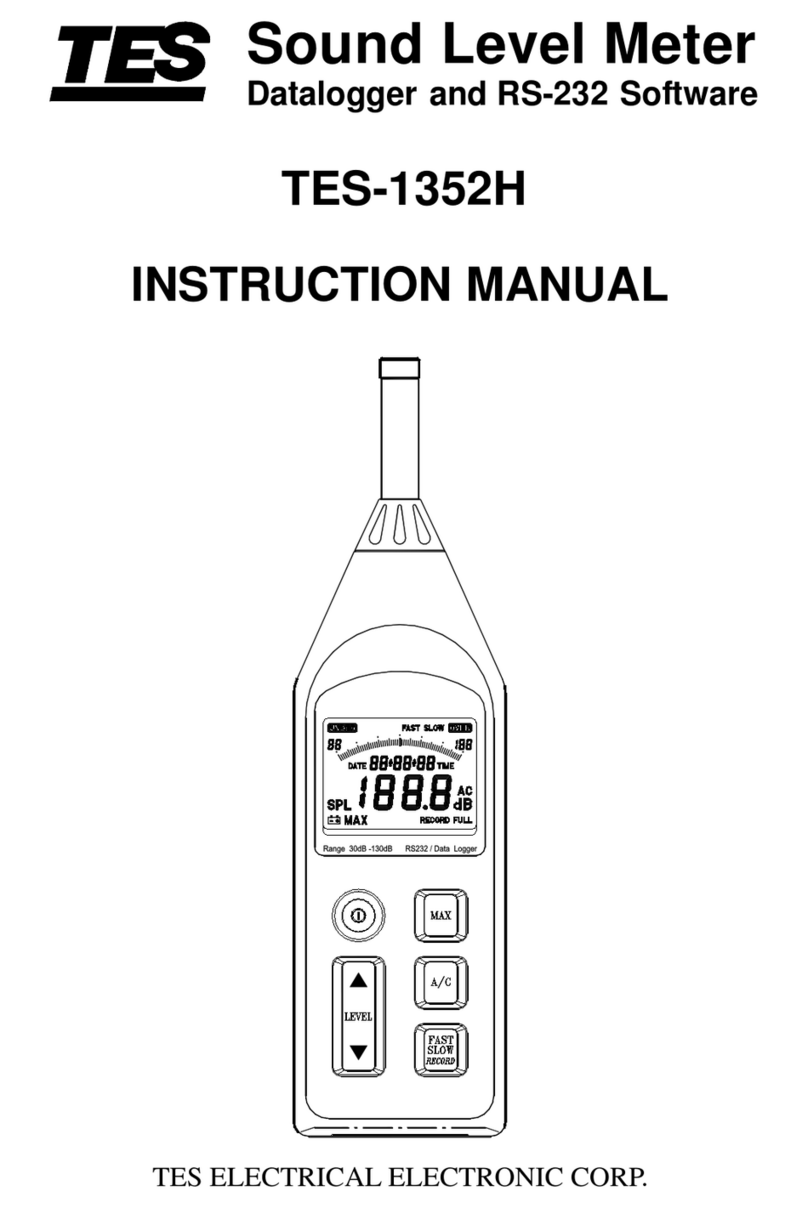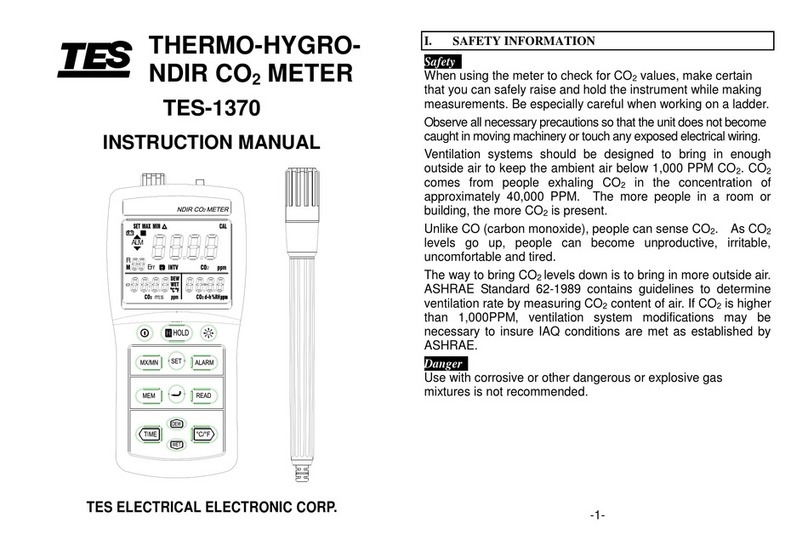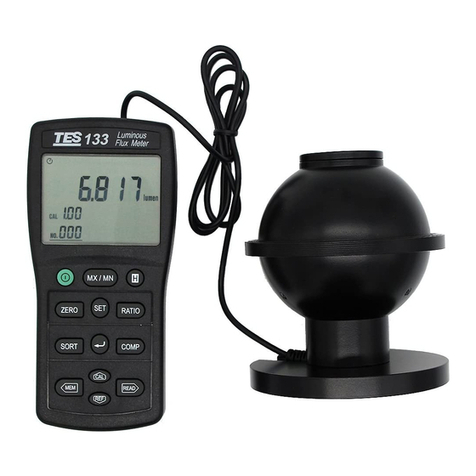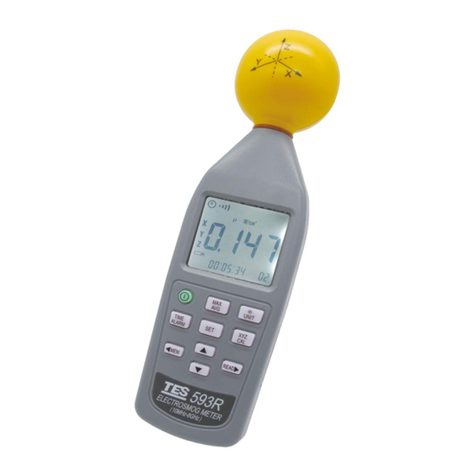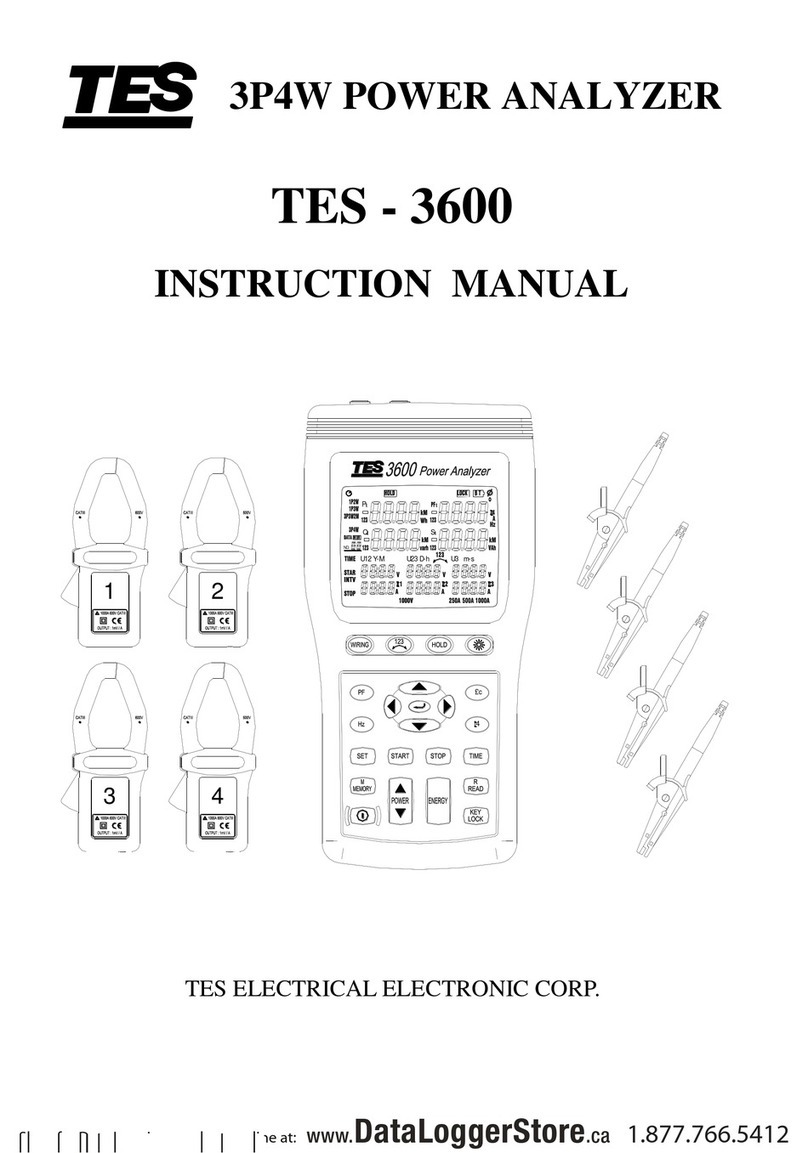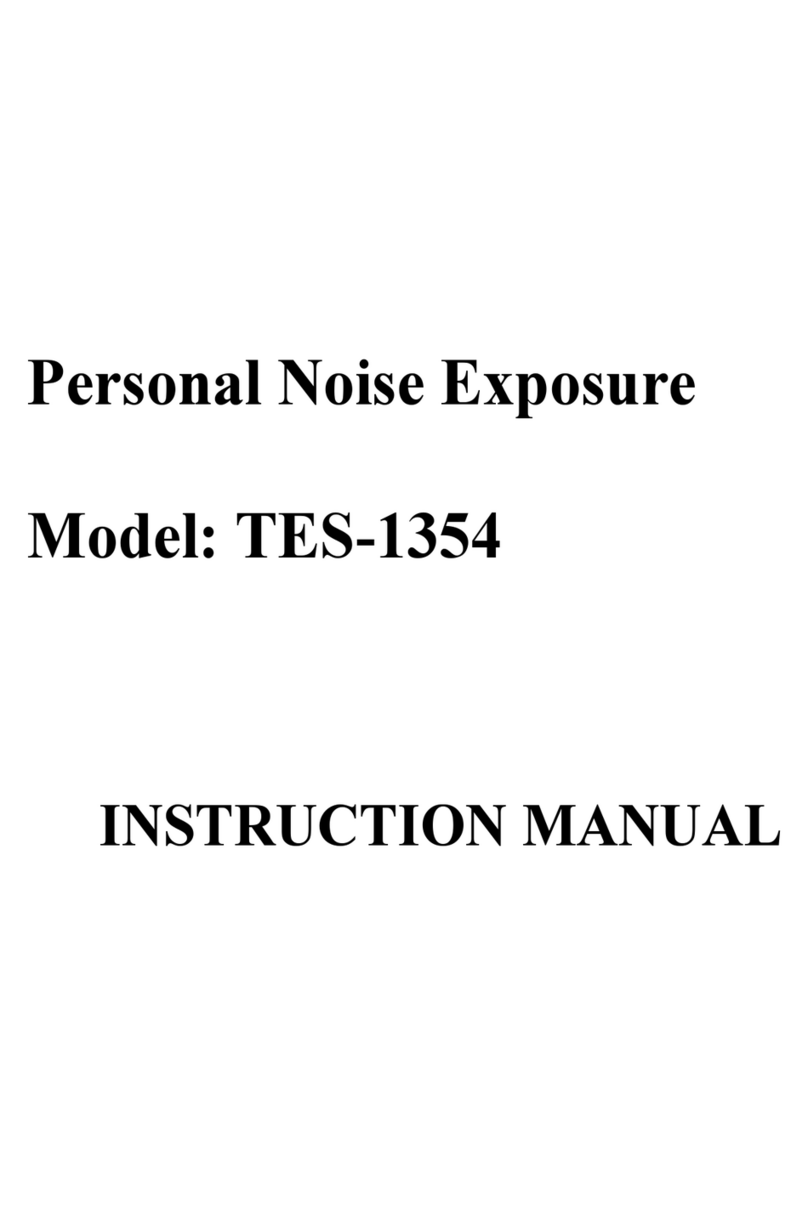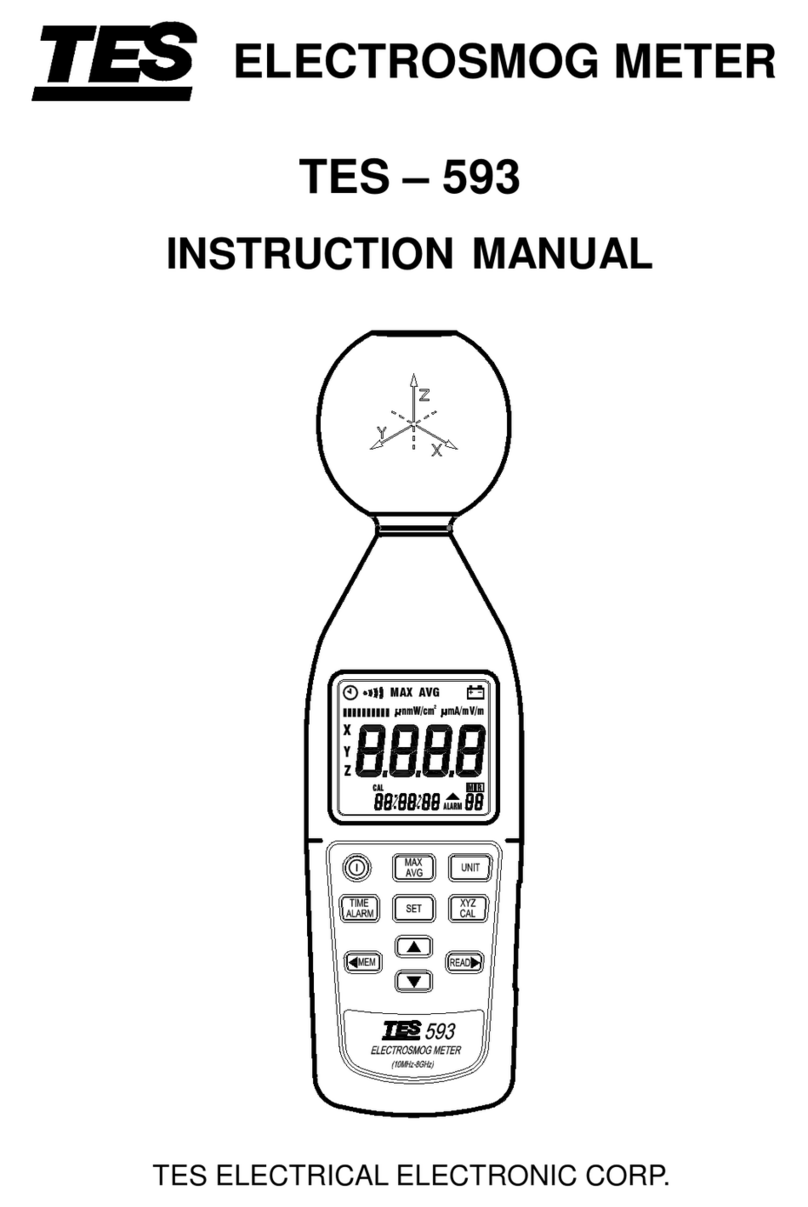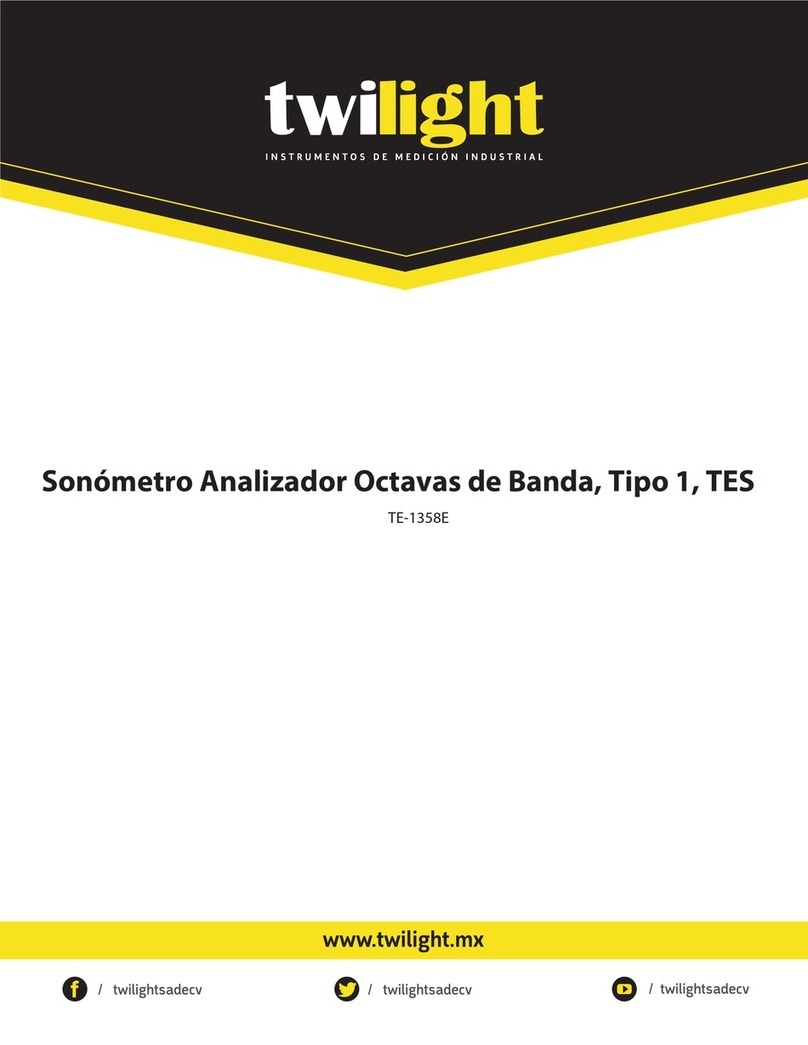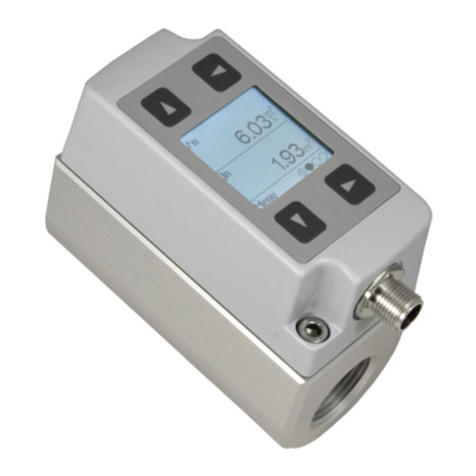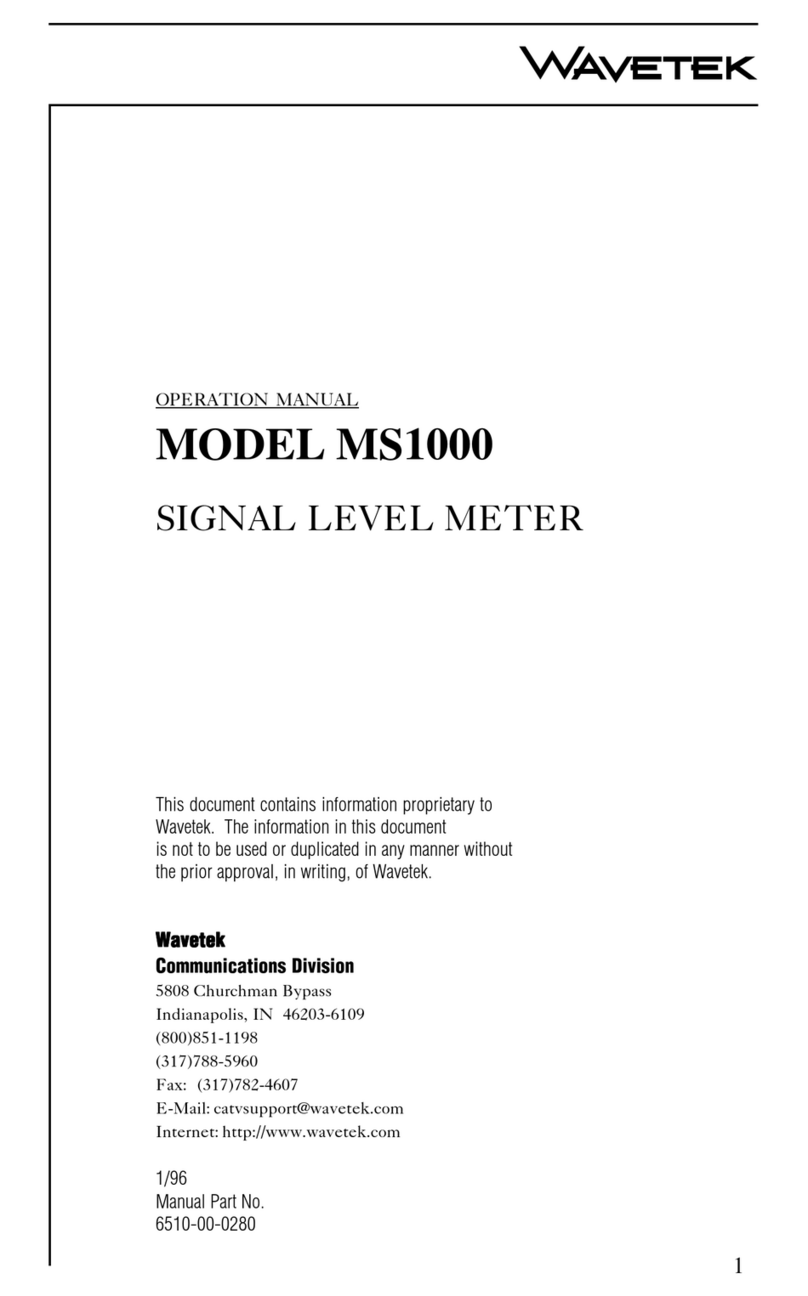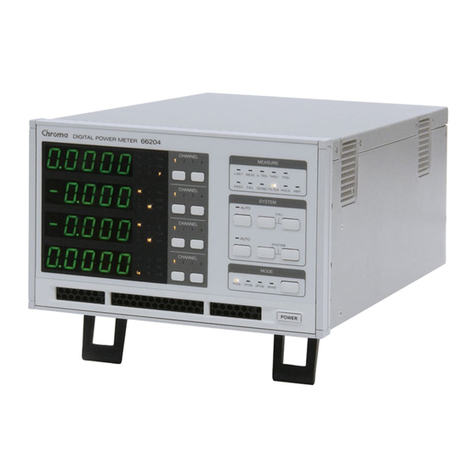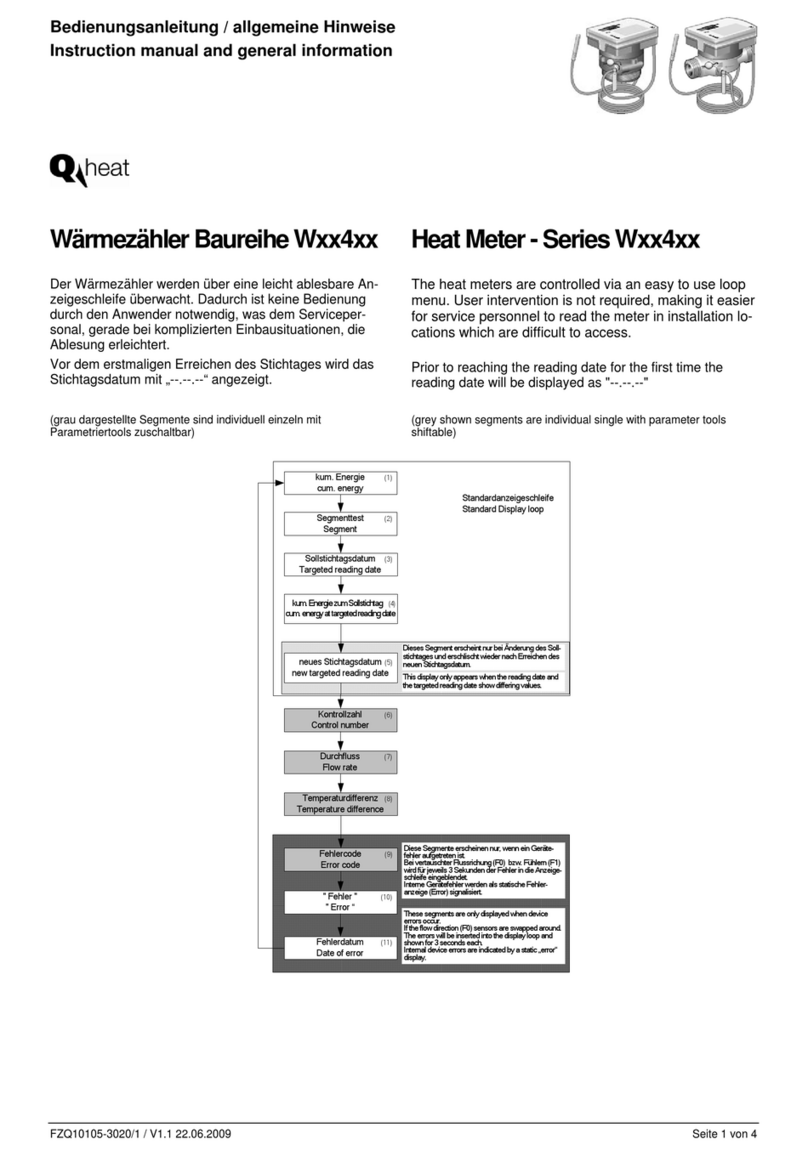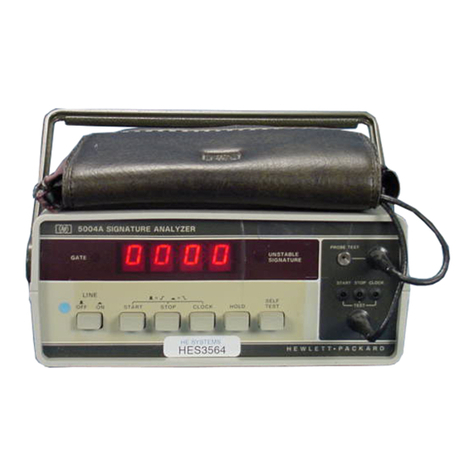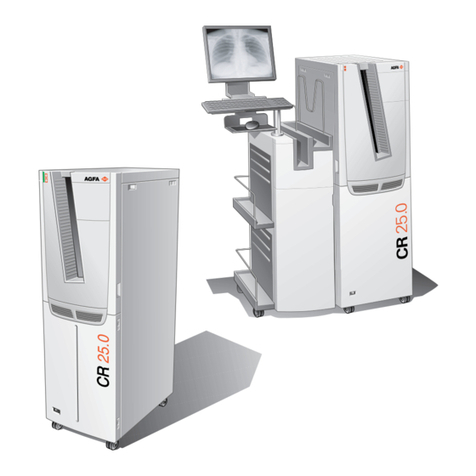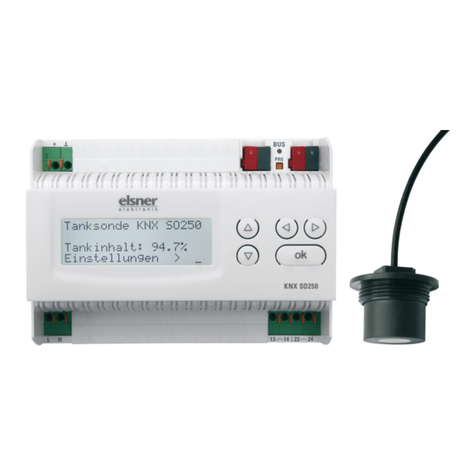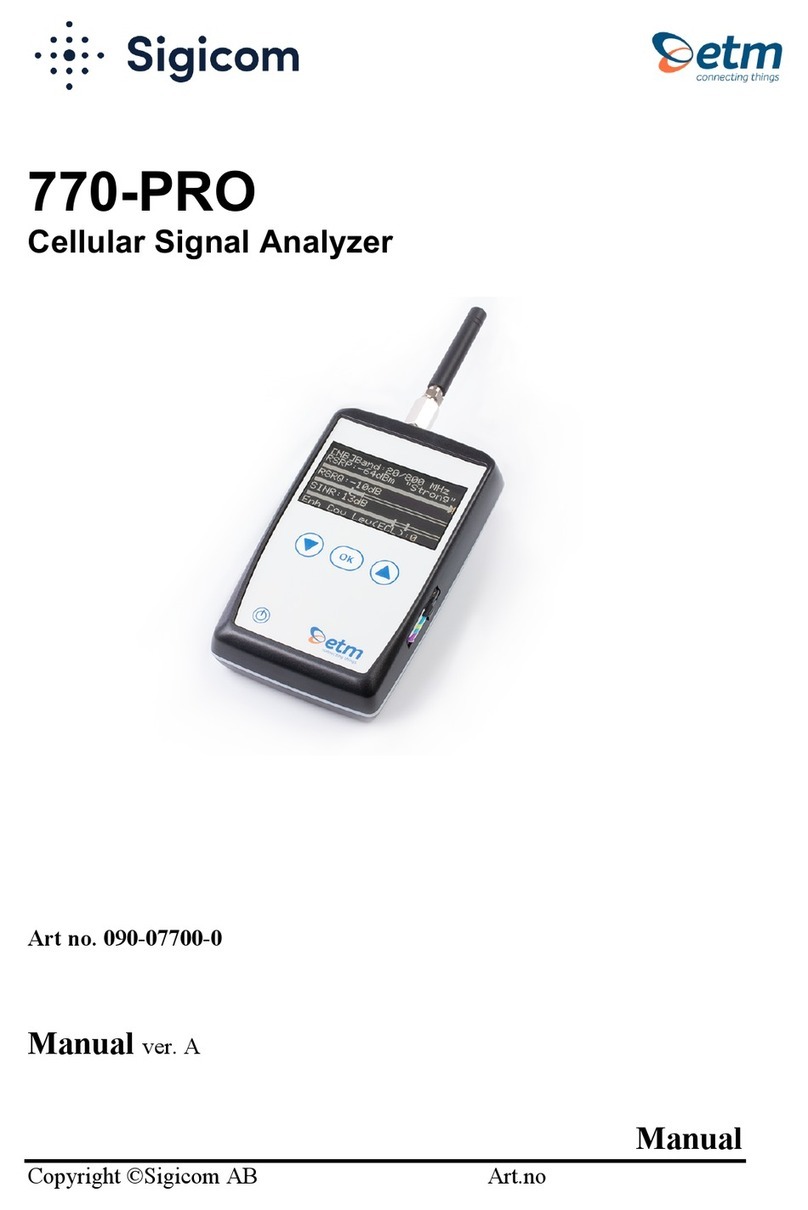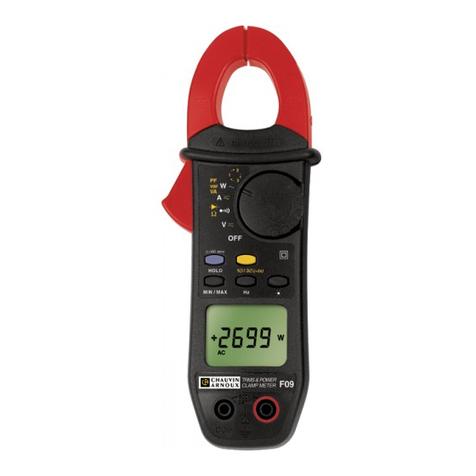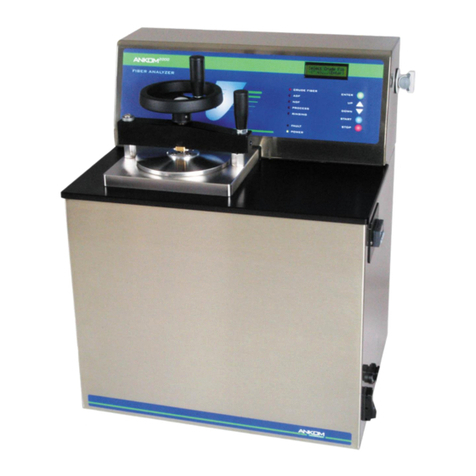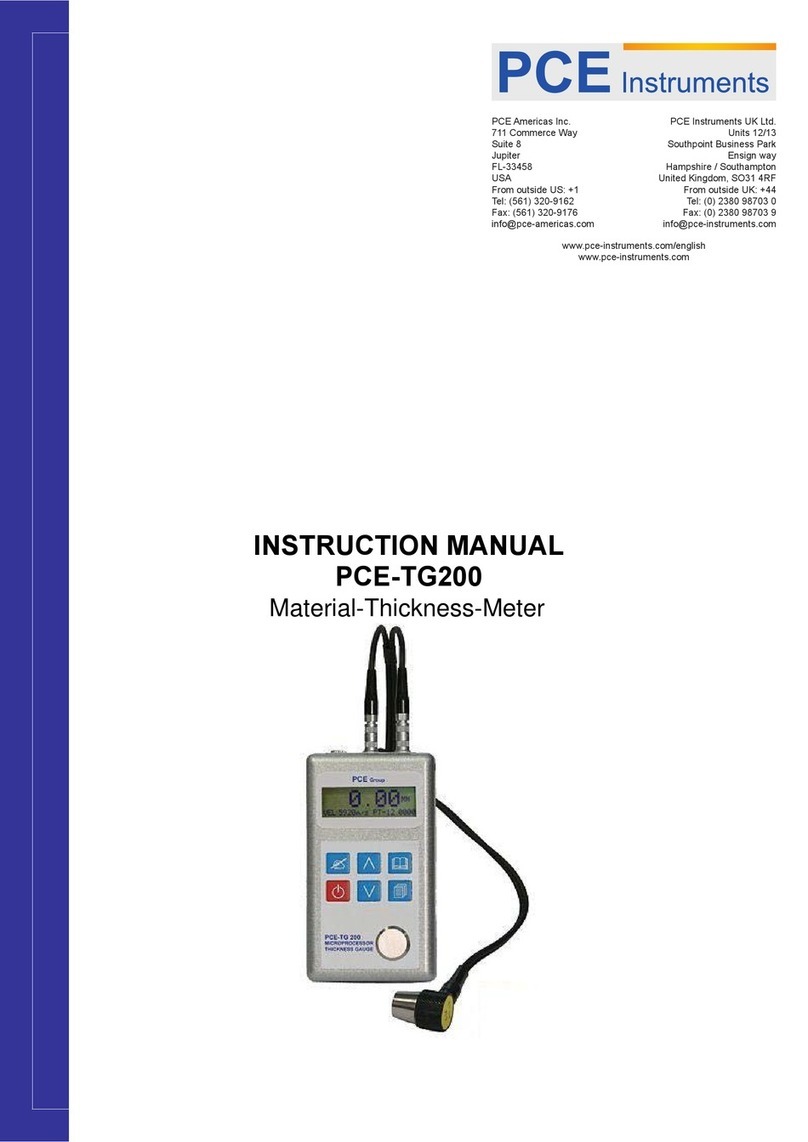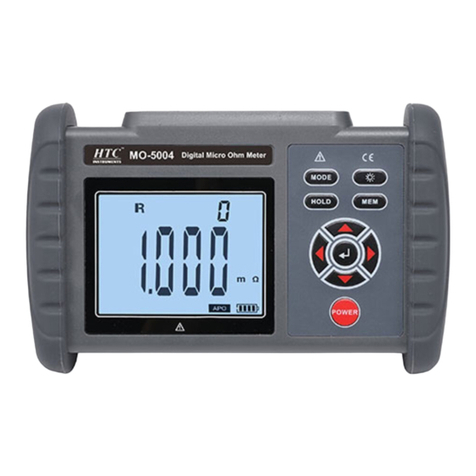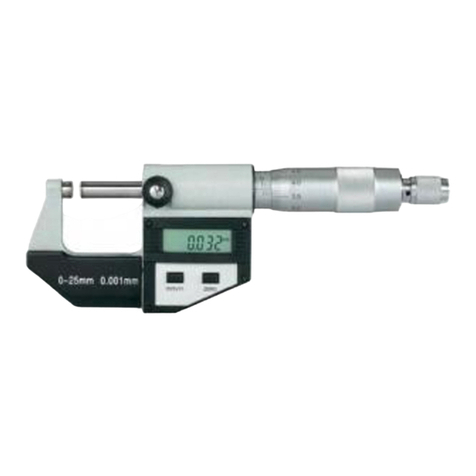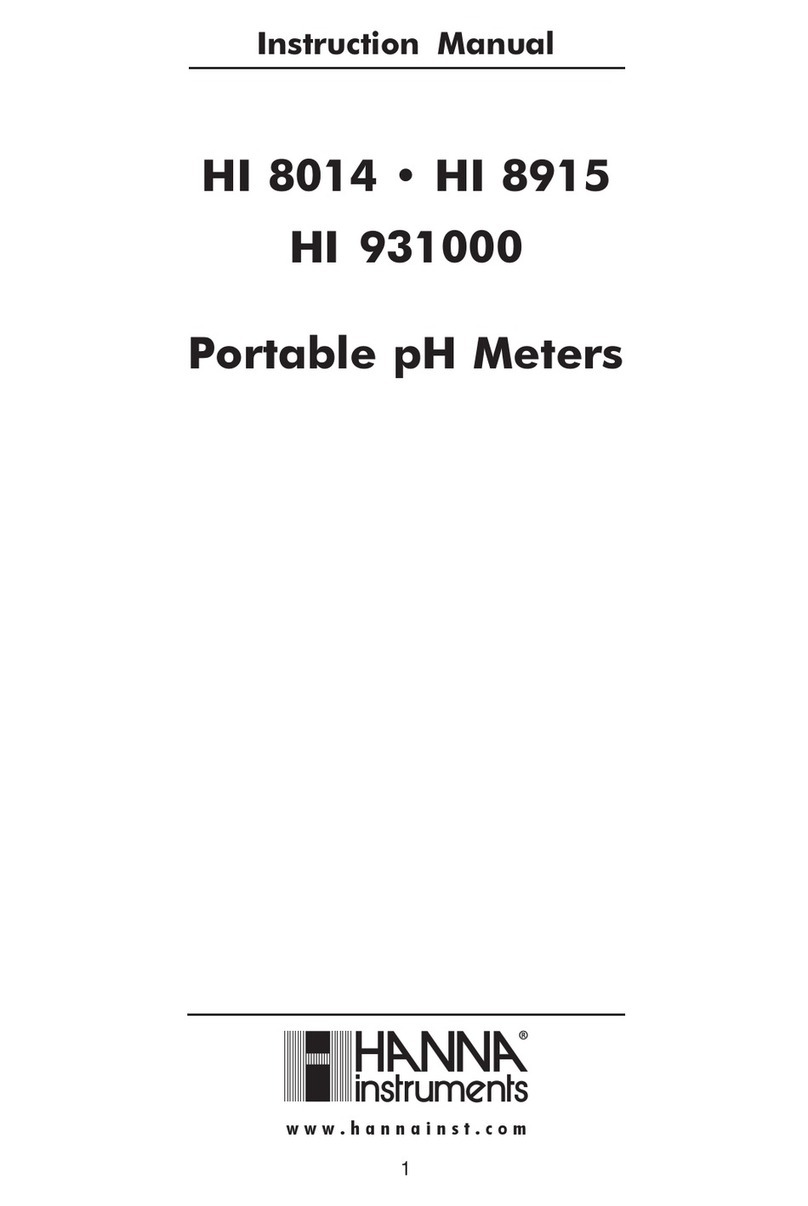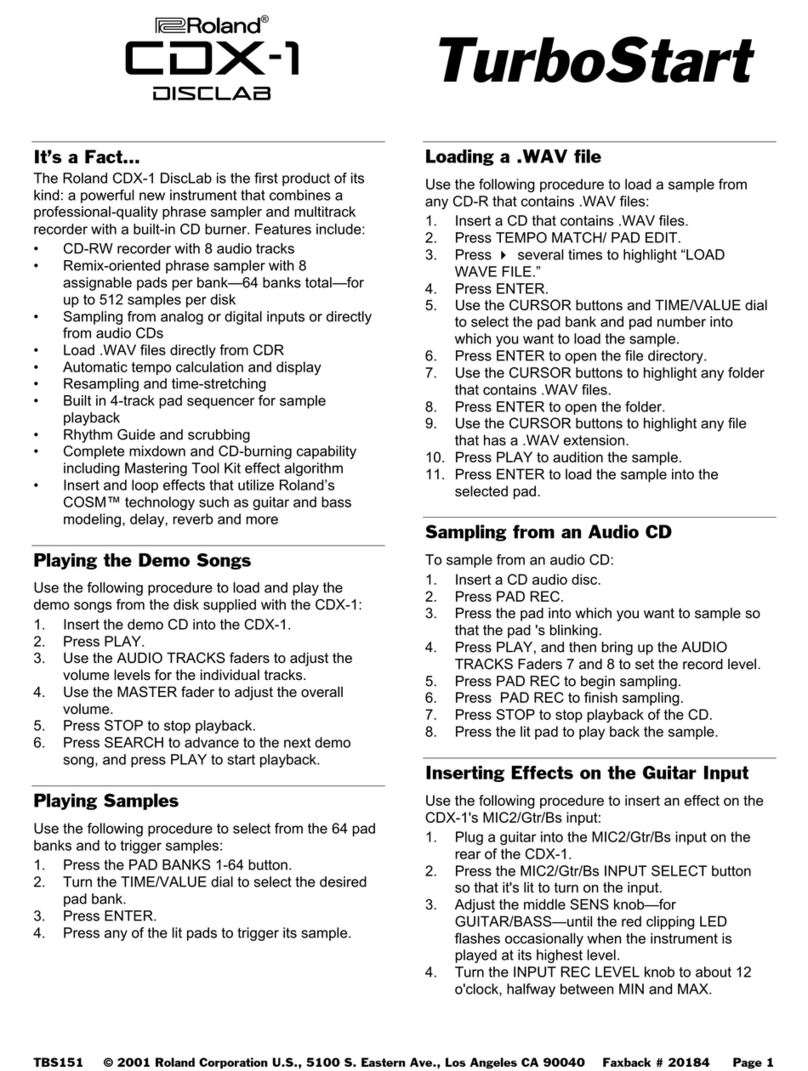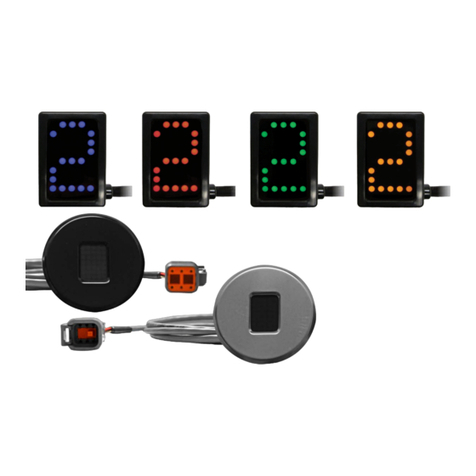TES TES-1353S User manual

INTEGRATING
Sound Level Meter
TES-1353S
INSTRUCTION MANUAL
※
Enclosed CD : Software & Protocol Inside.
INTEG
DATE
TIME
TIME
A/C
ERASE
Leq SEL SPL
RECORD
MAX
TES ELECTRICAL ELECTRONIC CORP.

CONTENTS
Title Page
1. INSTRUMENT CARE...............................................................1
2. FEATURES ..............................................................................1
3. MEASUREMENT PARAMETERS............................................2
4. SPECIFICATIONS....................................................................2
5. CONTROLS AND FUNCTIONS...............................................8
6. LCD DISPLAY DESCRIPTION...............................................10
7. PREPARATION FOR USE.....................................................12
8. CALIBRATION PROCEDURE ...............................................14
9. MEASUREMENT PROCEDURE............................................15
10. SETTING THE CURRENT TIME AND DATE.......................17
11. STORE RECORD DATA OPERATION.................................18
12. OUTPUT CONNECTORS ....................................................22
13. SOFTWARE INSTALLATION AND OPERATION................23
※
Copyright ©
2013 TES Electrical Electronic Corp. All rights reserved.

1
1. INSTRUMENT CARE
Do not attempt to remove the mesh cover from the microphone as this will cause
damage and affect the accuracy of the instrument.
Protect the instrument from impact. Do not drop it or subject it to rough handling.
Transport it in the supplied carrying case.
Protect the instrument from water, dust, extreme temperatures, high humidity and
direct sunlight during storage and use.
Protect the instrument from air with high salt or sulphur content, gases and stored
chemicals, as this may damage the delicate microphone and sensitive electronics.
Always turn the instrument off after use. Remove the batteries from the instrument if
it is not to be used for a long time. Do not leave exhausted batteries in the
instrument, as they may leak and cause damage.
Clean the instrument only by wiping it with a soft, drycloth or, when necessary, witha
cloth lightly moistened with water. Do not use any solvents, alcohol or cleaning
agents.
2. FEATURES
The Sound Level Meter complies with the requirements of IEC 61672-1:2003 standard
for a Class 2 instrument.
The instrument contains several features which permit sound level measurements
under a variety of conditions.
Features include:
Ease of use.
Easy to read large display.
Five measurement ranges.
Fast, Slow and Impulse time weightings.
A and C frequency weightings.
Storage of up to 200M measurement records (microSD CARD 4GB).
USB serial port for downloading records to a computer or real time analysis to a
computer.
Both AC and DC signal outputs are available from a single standard 3.5mm
coaxial socket suitable for use with a frequency analyzer, level recorder, FFT
analyzer, graphic recorder, etc.
SPL, Leq, SEL, SPL MAX, SPL MIN, PH (Peak Hold), L05, L10, L50, L90, and
L95, eleven measured parameters are monitored during measurement and can
be viewed selectively by pressing the
Leq SEL SPL
button.
Sound level alarm output connector.

2
3. MEASUREMENT PARAMETERS
The following parameters are used on the instrument.
A →“A” frequency weighting sound pressure level
C →“C” frequency weighting sound pressure level
FAST →Fast time weighting
SLOW →Slow time weighting
IMP →Impulse time weighting
SPL →Current time-weighted sound pressure level
Leq →Equivalent continuous sound level
SEL →Sound exposure level
SPL MAX →Maximum sound pressure level
SPL MIN →Minimum sound pressure level
PH →Peak Hold sound pressure level
L:05 →5% percentile sound level
L:10 →10% percentile sound level
L:50 →50% percentile sound level
L:90 →90% percentile sound level
L:95 →95% percentile sound level
SPL“MAX” →Maximum time-weighted sound pressure level (MAX symbol blink)
The various settings depend on the condition the instrument was in before it was last
turned off.
4. SPECIFICATIONS
Applicable standards: IEC61672-1: 2003 Class 2
ANSI S1.4 : 1983 Type 2
Measurement functions:
•
Main processing functions
Sound level: Current time-weighted sound pressure level A or current time-
weighted sound pressure level C
Maximum time-weighted sound pressure level A or Maximum time-weighted
sound pressure level C
Minimum time-weighted sound pressure level A or Minimum time-weighted
sound pressure level C
Equivalent continuous sound level Leq A or Leq C
Sound exposure level SEL A or SEL C

3
Peak Hold sound level PH A or PH C
Percentile sound level L : 05 A or L : 05 C
L : 10 A or L : 10 C
L : 50 A or L : 50 C
L : 90 A or L : 90 C
L : 95 A or L : 95 C
•
Measurement time : 1second to 24 hours
•
Measuring ranges
RMS : Total range: 30 to 130dB
Peak Hold : A – weighted or C – weighted over the top 30dB of each
measurement range.
30 – 90 : 63 – 93dB Peak Hold
40 – 100 : 73 – 103dB Peak Hold
50 – 110 : 83 – 113dB Peak Hold
60 – 120 : 93 – 123dB Peak Hold
70 – 130 : 103 – 133dB Peak Hold
•
Max. measurement level: 130dB
•
Self-generated noise level:
Typical values at 23℃using the nominal microphone equivalent capacitance of 27pF
(30-90dB range)
Weighting Electrical Total
“A” 22.7dB 26.1dB
“C” 21.8dB 29.5dB
Linearity operating range: A-weighted, 1000Hz, 60dB dynamic range.
Total linear operating range:
In accordance with IEC 61672-1, A-weighted, 1000Hz: 30dB to 130dB.
Level range selection:
5 ranges in 10dB steps 30 to 90dB , 40 to 100dB
50 to 110dB , 60 to 120dB
70 to 130dB
LINEAR OPERATING RANGES (L.O.R.)
RANGE: 30 – 90 dB. Test starting point 64 dB for all weightings and frequencies except
31.5Hz A-weighted, for which the starting point is 44 dB.
FREQUENCY
Hz WEIGHTING L.O.R.
dB WEIGHTING L.O.R.
dB
31.5 A 36.1 – 50.6 C 39.5 – 87.0
1000 A 36.1– 90.0 C 39.5 – 90.0
4000 A 36.1 – 90.0 C 39.5 – 89.2
8000 A 36.1 – 88.9 C 39.5 – 87.0

4
RANGE: 40 – 100 dB. Test starting point 74 dB for all weightings and frequencies except
31.5Hz A-weighted, for which the starting point is 54 dB.
FREQUENCY
Hz WEIGHTING L.O.R.
dB WEIGHTING L.O.R
dB
31.5 A 40.0 – 60.6 C 40.0 – 97.0
1000 A 40.0 – 100.0 C 40.0 – 100.0
4000 A 40.0 – 100.0 C 40.0 – 99.2
8000 A 40.0 – 98.9 C 40.0 – 97.0
RANGE: 50 – 110 dB. Test starting point 84 dB for all weightings and frequencies except
31.5Hz A-weighted, for which the starting point is 64 dB.
FREQUENCY
Hz WEIGHTING L.O.R
dB WEIGHTING L.O.R
dB
31.5 A 50.0 – 70.6 C 50.0 – 107.0
1000 A 50.0 – 110.0 C 50.0 – 110.0
4000 A 50.0 – 110.0 C 50.0 – 109.2
8000 A 50.0 – 108.9 C 50.0 – 107.0
RANGE: 60 – 120 dB. Test starting point 94 dB for all weightings and frequencies except
31.5Hz A-weighted, for which the starting point is 74 dB.
FREQUENCY
Hz WEIGHTING L.O.R.
dB WEIGHTING L.O.R.
dB
31.5 A 60.0 – 80.6 C 60.0 – 117.0
1000 A 60.0 – 120.0 C 60.0 – 120.0
4000 A 60.0 – 120.0 C 60.0 – 119.2
8000 A 60.0 – 118.9 C 60.0 – 117.0
RANGE: 70 – 130 dB. Test starting point 104 dB for all weightings and frequencies
except 31.5Hz A-weighted, for which the starting point is 84 dB.
FREQUENCY
Hz WEIGHTING L.O.R.
dB WEIGHTING L.O.R.
dB
31.5 A 70.0 – 90.6 C 70.0 – 127.0
1000 A 70.0 – 130.0 C 70.0 – 130.0
4000 A 70.0 – 130.0 C 70.0 – 129.2
8000 A 70.0 – 128.9 C 70.0 – 127.0
Frequency range: Overall characteristics including microphone: 31.5 to 8000Hz
Frequency weighting: A,meets the requirement of IEC 61672-1 for class 2 “A”
weighting.
C,meets the requirement of IEC 61672-1 for class 2 “C”
weighting.

5
Time weighting (RMS detection): Fast, according to IEC 61672-1 class 2.
Slow, according to IEC 61672-1 class 2.
Impulse, according to IEC 61672-1 class 2.
•
Reference conditions:
Type of the acoustic field: Free
Reference sound pressure level: 94.0dB (related to 20µPa)
Reference level range: 60 to 120dB
Reference frequency: 1000Hz
Reference temperature: +23℃
Reference relative humidity: 50%RH
Reference static pressure: 101.325 kPa
Reference incidence direction: Perpendicular to the front of the microphone
diaphragm.
•
Calibration:Acoustic using calibrator TES-1356 or equivalent.
Calibration check frequency is 1000Hz.
Nominal calibration level for the free field: 94.1dB
Nominal calibration level for the diffuse field: 94.0dB
•
Frequency for acoustic testing: 8000Hz.
•
Warm-up time: ≦2min
•
Sampling interval: Bar graph indication →125 ms approx.
Numeric indication →1 sec approx.
•
Data record capacity: Data can be stored in the memory.
Max. 200M data can be stored (micro SD CARD 4GB).
Max. 255 blocks can be split.
•
Microphone equivalent electrical impedance (electrical input device):
Replace the microphone capsule with a series capacitance of 27pF +/- 3pF.
Display LCD
•
Display screens:
4 digit numerical indication of sound level, from 30.0 to 130.0dB with 0.1dB
resolution.
Bar-graph indication of current sound level with 1dB resolution.
Sound level range indicator: 30–90dB, 40–100dB, 50–110dB, 60–120dB or
70–130dB in five ranges.
Time display; year – month – day and hour: minute: second.
•
Display update rate: 1 second
•
Display first indication: Depends on the condition the instrument when it was last
turned off.
•
Warning indications:
Out-of-range indications:
OVER displayed at upper limit of the range
UNDER displayed at lower limit of the range

6
Outputs
•
AC output (using selected frequency weighting)
Output voltage: 2Vrms (at full-scale of the range)
Output impedance: 5kΩ
Load impedance: ≧1MΩ
•
DC output
Output voltage: 10mV/dB
Output impedance: 5kΩ
Load impedance: ≧1MΩ
•
I/O connector: Sound level meter control from and data output to a computer (USB)
•
Alarm output: 5Vdc, typical
Power requirements
•
Qty 4 x 1.5V IEC R6P (size “AA”) manganese super heavy duty batteries or
equivalent.
•
Battery life: Approx. 24 hours
•
External power source: DC voltage from 5V to 6V
Current rating: Approx. 20mA @ 6V
Ambient conditions:
•
Operating conditions: -10℃to +50℃, 30% to 90%RH non-condensing
•
Storage conditions: -10℃to +60℃, <70%RH non-condensing
•
Effect of temperature: < 0.5dB (-10 to +50℃)
•
Effect of humidity: < 0.5dB (for 30%RH to 90%RH at 40℃, 1000Hz)
•
Effect of vibration: A 40 Hz 1m/s vibration produces no noticeable effect.
•
Effect of magnetic field: No noticeable effect.
Compliance with standards:
•
:indicates compliance with applicable European Union Directives.
•
EMC Emission: IEC 61000-6-3, Generic emission standard for residential,
commercial and light industrial environments.
No significant emissions from the instrument.
IEC 61672-1, Instrumentation standard classification group X and
performance class 2 sound level meter.
•
EMC Immunity: IEC 61000-6-2, Generic standard-Immunity for industrial
environments.
No degradation in performance when subjected to 10V/m
unmodulated.

7
IEC 61672-1, Instrumentation standard classification group X and
performance class 2 sound level meter.
No permanent degradation of performance, loss of function,
change of operating state or configuration, or loss or corruption of
stored data due to ESD discharges as specified in the above
standard.
•
No degradation in performance when the instrument was subjected to ESD at 8kV
per IEC 801-2.
Dimensions: Approx. 265(L)×72(W)×36(H) mm
Weight (including battery): Approx. 380g
Supplied accessories: Instruction manual, Batteries, Adjustment screwdriver, CD
software, Windscreen, USB connecting cable, 3.5φplug,
Carrying case.
Optional equipment (Not supplied): AC adaptor, Sound calibrator TES-1356,
Portable thermal printer, Thermal printer connecting cable,
Microphone extension cable.

8
5. CONTROLS AND FUNCTIONS
1. 1/2-inch microphone
2. Display: The LCD shows the sound level as a numeric value and a bar graph. The
display also shows the operation mode of the instrument, the selected
measurement parameters and warning indications.
3. Button: Press to turn the instrument on and off.
4.
Leq SEL SPL
button : Press this button the following parameters are monitored during
integrating measurement and can be viewed selectively :
Leq with integrating start time.
SEL with integrating stop time.
SPL MAX Maximum sound level with time.
SPL MIN Minimum sound level with time.
PH Peak Hold sound level.
L05, L10, L50, L90, and L95 percentile sound levels.

9
5. button :
Press to start ( “ ” measurement symbol) or pause ( “ ” pause symbol) the
integrating sound level measurement (including the various processing functions)
or the data recording. When the measurement period is completed, the ( “” end
symbol) indication is shown on the display.
Press this button 2 seconds to exit the integrating measurement or the data record.
If the end “” symbol is shown on the display, press this button 2 seconds will clear
the last integrating measure data and the “” symbol will disappear, back to normal
sound level measurement mode.
6. button :
Level range buttons: select the level range for the measurement.
The following five settings are available: 30 to 90dB, 40 to 100dB, 50 to 110dB,
60 to 120dB, 70 to 130dB.
Press these buttons to increment or decrement setting values.
7.
A / C
button : Sets the frequency weighting to A or C mode.
8.
SLOW
IMPUSE
FAST
button : Sets the time weighting to FAST, SLOW or IMPULSE mode.
FAST : uses a 125ms-time constant. This setting is used in
most situations.
SLOW : uses a 1s time constant, which smooth out fluctuating
levels.
IMPULSE : uses a 35ms time constant with a slow decay, which
allows readings of short-duration sound events.
9.
MAX
button : Used for reading the maximum time-weighted sound level
encountered during a measurement.
Press this button to enter maximum recording mode. The “MAX”
indicator will blink appear on the display. Press again to exit
maximum recording mode.
10.
RECORD
ERASE
button :
Data records mode : Press this button enter to data records mode.
Erase all records : Turn off the meter, press and hold down this button then turn on
the meter, until the “CLr” indication is shown on the display.
11.
DATE
TIME
button :
Press this button, will change displayed from “hour : minute : second” to “year –
month - day” about 2 seconds.
Setting the current date and time. Turn off the meter, pressandholddown this button
then turn on the meter enter to date and time setting mode.
Preset the start timeofthedata records. Pressthisbutton3secondstosettingthestart
time of the data records.

10
12.
INTEG
TIME
button :
Select the default measurement time : Press this button one time enter to
integrating measurement time select mode, use “ ” buttons to select
the measurement time, new manual setting time→
--:--:--
→1sec→3sec→10sec
→30sec→1min→5min →8min→10min→15min→30min→1hour→8hour→24hour.
Setting to desired measurement time : Press this button 2 seconds enter to other
desired integrating measurement time setting mode, the setting range from 1
second to 100 hours.
13. micro SD CARD 4GB.
14. CAL potentiometer: Calibration potentiometer for level adjustment.
15. Micro-USB: USB input/output connector for input of control signals and output of
measurement data.
16. ALARM output: Sound level alarm output.
17. Thermal printer output jack: Connection the PROVA 300XP printer.
18. AC/DC output socket: AC output signal with frequency weighting.
DC output signal corresponding to sound level.
19. External DC power supply socket: Type 1.3 coaxial power connector; center
negative, nominal 6V DC.
20. Tripod mounting: ¼” - 20 UNC Female thread.
21. Battery cover.
6. LCD DISPLAY DESCRIPTION

11
1. Sound level range indicator (5 ranges): 30–90dB, 40–100dB, 50–110dB, 60–120dB
and 70–130dB
2. Bar graph shows the current sound level (1dB resolution).
3. Date/time and elapsed time indicator : During integrating this indicator shows the
elapsed time in seconds.
During viewed the peak hold sound level this indicator the “PH”.
During viewed the percentile tile sound level this indicator shows the L:05, L:10,
L:50, L:90 and L:95 parameters.
Others this indicator shows the “year - month - day” or “hour : minute : second”.
4. Leq: Equivalent continuous sound level reading
5. SEL: Sound exposure level reading
6. SPL: Time-weighted sound level reading “Sound Pressure Level”
7. Low-battery indication
8. MAX: Maximum time-weighted sound level reading (blink displayed).
Maximum sound level reading.
9. MIN: Minimum sound level reading.
10. REC : Data records indicator
11. Sound level reading (0.1dB resolution): 30.0 – 130.0dB
12. FULL: Data records full indicator
13. dB: Sound level unit
14. A, C: “A” Frequency weighting or “C” Frequency weighting indicator.
15. IMP: Impulse time weighting indicator
16. OVER : Over-range indicator, if this indicator is flashing, to indicate that over-range
data were included in the sound level measurement values for processing.
17. SLOW: “Slow” time weighting indicator
18. FAST: “Fast” time weighting indicator
19. : End integrating sound level measurement indicator.
Press button 2 seconds exit this mode.
20. : Pause integrating sound level measurement indicator.
Press button again to resume measurement.
21. : Start and continuous integrating measurement indicator.
22. UNDER: Under-range indicator, if this indicator is flashing, to indicate that under –
range data were included in the sound level measurement values for
processing.

12
7. PREPARATION FOR USE
Power Supply
The instrument can be powered by internal batteries, or for extended operation by an
optional external 6V DC supply such as a suitable AC mains adapter or battery pack.
Rechargeable batteries may be used in the instrument, but cannot be recharged when
fitted as the instrument is not designed to recharge batteries.
Before inserting or replacing the batteries and before connecting the AC adaptor, be
sure to turn the instrument off.
1. Battery Installation
When the low battery indication symbol “
” appears on the display, there is
insufficient power to make accurate measurements and the batteries must be
replaced.
Before replacing the batteries, press the button to turn off the instrument.
Use a screwdriver to loosen the screw in the battery cover. Remove the cover
from the battery compartment. Retain the screw and cover.
Observing correct polarity as indicated in the compartment, insert four batteries
of the type given in section 4. “Specifications”.
Refit the battery cover and screw. Use a screwdriver to tighten the screw.
Press the button to turn on the instrument and check for correct operation.
Note: Take care not to reverse the (+) and (-) polarity when inserting the batteries,
otherwise the instrument may be damaged.
Always replace all four batteries at the same time.
Do not mix old and new batteries or batteries of different types.
Remove the batteries from the instrument if it is not to be used for a month or
longer.
2. Using an external power source.
Insert the plug of the ACadaptor or external battery pack into the DC 6V (DCsource
from 5V to 6V) socket on the side of the instrument. When a connector is inserted
into this socket, the internalbatteries will be disconnected and the instrument will be
powered from the external source. The low battery symbol “
” will appear on
the display if the external voltage is insufficient for the instrument to provide
accurate measurements.
Note: Ensure the external power source is connected with the polarity as indicated
in the following diagram, otherwise damage may be caused to the instrument and
external power source.

13
3. Windscreen
When making measurements outdoors in strong winds or when measuring air
conditioning equipment or similar, wind noise and strong air movements at the
microphone can cause measurement errors. Such effect can be reduced by using
the windscreen.
4. Tripod Mounting
For long-term measurements, the instrument may be mounted on a standard
camera tripod using the integral ¼” x 20 UNC mounting thread.

14
8. CALIBRATION PROCEDURE
Most national standards recommend that you calibrate your sound level meter before
each set of measurements and check the calibration after each set.
The procedure to check/adjust the displayed sound level in response to acoustic
calibrator types TES-1356 or equivalent is as follows:
1. Turn off the sound calibrator.
2. Press the button to turn on the instrument.
3. Use the “ ” buttons to select the 60 to 120dB
reference sound level range.
4. Use the “
A / C
” button to select “A” frequency weighting.
5. Use the “
SLOW
IMPUSE
FAST
” button to select “FAST” time weighting.
6. Insert the microphone very carefully and slowly all the way
into the sound calibrator coupling orifice.
7. Switch on the 1000Hz sound calibrator in its nominal 94 dB
level setting.
8. Adjust the CAL potentiometer of the instrument, until the
display reading for diffuse field is the same as the certified
pressure level of the calibrator, or is 0.1 dB higher than this
pressure level for free-field. This applies to calibrators type
TES-1356.
9. Set the power switch of the sound calibrator to OFF.
10. Remove the microphone very carefully and slowly from the
coupler.
SOUND-LEVEL
CALIBRATOR
114dB1KHz
OFF
94dB
INTEG
DATE
TIME
TIME
ERASE
Leq SEL SPL
RECORD
MAX
A/C

15
9. MEASUREMENT PROCEDURE
9-1 Sound level measurement
1. Press the button to turn on the instrument. The initial state depends on the
condition the instrument was in before it was last turned off.
2. Press the “
A / C
” button to select the desired frequency weighting. For normal
sound level measurements, select the “A” setting.
3. Press the “
SLOW
IMPUSE
FAST
” button to select the desired time weighting (dynamic
characteristics). Normally, the “FAST” setting should be used.
4. When performing measurement according to IEC or other standards, the frequency
weighting and time weighting setting required by the standard should be selected.
5.Press the “ or ” buttons to select desired levelrange. Choose asetting
in which the bar graph indication registers approximately the middle of the range. If
the “ OVER
” indicator appear during measurement, the upper limit of the selected
range has been exceeded. Increase the range setting until the symbol remains off
during measurement. Similarly, if the “ UNDER ” indicator appears, reduce the
range setting until the symbol remains off during measurement. Both indicators are
non-latching and will clear when the correct range is selected.
6. The numeric level indication shows the currently measured sound level. The
reading is updated once every second.
Press
DATE
TIME
button changed from current time “hour : minute : second” to current
date “year – month - day” displayed about 2 seconds.
7. Press the “
MAX
” button to record the maximum time-weighted sound level
encountered during a measurement period; the “MAX” indicator will blink appearon
the display. Press this button again to exit this mode.
9-2 Equivalent continuous sound level (Leq) measurement
Sound exposure level (SEL) measurement
Maximum sound level (SPL MAX) measurement
Minimum sound level (SPL MIN) measurement
Peak Hold sound level (PH) measurement
Percentile sound level (L05, L10, L50, L90 and L95) measurement
When using this meter in a mode other than sound level measurement, all
processing functions provided by the meter are carried out simultaneously. For
example, when equivalent continuous sound level measurement is selected, the
exposure level, and percentile level, are also deterimined.
1. Press button turn on the meter.
2. Press
A / C
button to select desired frequency weighting. For normal
measurements, select the “A” setting.
3. Press
SLOW
IMPUSE
FAST
button to select desired time weighting. Normally, the “FAST” setting
should be used.

16
4. Press or buttons to select desired level range. Choose a setting in
which the bar graph indication registers to about the middle of the range. If the
“OVER” or “UNDER” indicators light up frequently, change the level range setting.
5. Setting the integrating measurement time.
Press
INTEG
TIME
button one time enter to select the default integrating measurement
time mode.
Press and buttons to cycle select the measurement time.
New manual setting time→-
-:-
-:-
- →1sec→3sec→10sec→30sec→1min
24hours←8hours←1hours ←30min←15min ←10min ←8min←5min
Waiting for about 5 seconds will auto stored the selected and exit this mode.
When you select “-
-:-
-:-
-” means the integrating measurement time without limit.
Press
INTEG
TIME
button 3 seconds enter to manual setting the integration
measurement time mode.
A flashing cursor indicates the currently selected parameter (the second).
Press and buttons to set desired second. Press
INTEG
TIME
button move
to the next parameter (the minute), repeat this procedure until you have set to
desired minute and hour. Press
INTEG
TIME
button to stored the desired
measurement time to the new manual setting time and exit this mode. The
maximum measurement time setting is 100 hours.
6. Press button to start the measurement, the “ ” symbol and the elapsed
measurement time is displayed.
When the measurement time has elapsed, the measurement terminates
automatically, the terminate symbol “” is shown.
During measurement, press button can be used to pause and resume the
measurement.
During pause, the pause symbol “ ” is shown.
When wishing to terminate the measurement earlier, press button, the
pause symbol “ ” is shown.
If an under-range condition or over-range condition occurs at least once during
measurement, the “OVER” or “UNDER” indicator appears, to shown that the
processing data contain over-range or under-range data.
During this procedure most of the buttons such as
A / C
button and level range
buttons are inoperative. Only the and
Leq SEL SPL
two buttons can be used.
All other settings must be made before starting the measurement. Any pause
intervals are not included in the measurement time.

17
7. When the measurement is pause or completed, press
Leq SEL SPL
button to cycle
switch displaying the following measurement result.
Leq : Equivalent continuous sound level with start measurement time.
SEL : Sound exposure level with terminate measurement time.
SPL MAX : Maximum sound level with time.
SPL MIN : Minimum sound level with time.
PH : Peak Hold sound level
L:05→5% percentile sound level
L:10→10% percentile sound level
L:50→50% percentile sound level
L:90→90% percentile sound level
L:95→95% percentile sound level
SPL INST→Current sound level with current time.
If “OVER” is flashing shown, the sound level data used for processing contained
over-range data.
If “UNDER” is flashing shown, the sound level data used for processing contained
under-range data.
It is also possible to use the
Leq SEL SPL
button during measurement to read the Leq,
SEL, SPL MAX, SPL MIN, PH (Peak Hold), L05, L10, L50, L90, L95 and SPL
sound level up to that point. This applies only to the numeric level display, the bar
graph indication shows the current sound level.
The percentile sound level only calculated to 100 hours.
8. Press button 2 seconds exit this measurement mode and clear the
measured result, the “ ” “ ” or “” symbol are disappeared, back to normal
sound level measurement.
10. SETTING THE CURRENT TIMEAND DATE
Date and time information is stored with each record block. Therefore, it is important to
make sure that this information is correct.
1. Press button turn off the meter.
2. Press and hold down
DATE
TIME
button, then press button turn on the meter, enter to
current date and time setting mode.
3. A flashing cursor indicates the currently selected parameter (the second), press
and buttons to set the current second.
4. Press
DATE
TIME
button move to the next parameter (the minute), press and
buttons to set the current minute.
5. Repeat step 4 until you have set the current hour, day, month, and year.
6. Press
DATE
TIME
button to store the new date and time, and exit this mode.

18
11. STORE RECORD DATA OPERATION
The meter incorporates a memory which can be used to store measurement data.
The maximum has 200M data capacity can be split up to 255 blocks record.
The record sampling interval time has been fixed at 1 second.
The record data has two method, with or without preset start time for record data.
11-1 Setting the record measurement time
1. Press
INTEG
TIME
button one time enter to select the default integrating measurement
time mode.
Press and buttons to cycle select the measurement time.
New manual setting time→-
-:-
-:-
- →1sec→3sec→10sec→30sec→1min
24hours←8hours←1hours ←30min←15min ←10min ←8min←5min
Waiting for about 5 seconds will auto stored the selected and exit this mode.
When you select “-
-:-
-:-
-” means the integrating measurement time without limit.
2. Press
INTEG
TIME
button 3 seconds enter to manual setting the integration measurement
time mode.
A flashing cursor indicates the currently selected parameter (the second).
Press and buttons to set desired second. Press
INTEG
TIME
button move to
the next parameter (the minute), repeat this procedure until you have set todesired
minute and hour. Press
INTEG
TIME
button to stored the desired measurement time to
the new manual setting time and exit this mode. The maximum measurement time
setting is 100 hours.
11-2 Setting the measurement weighting and range
1. Press
A / C
button to select desired frequency weighting. For normal
measurements, select the “A” setting.
2. Press
SLOW
IMPUSE
FAST
button to select desired time weighting. Normally, the “FAST” setting
should be used.
3. Press or buttons to select desired level range. Choose a setting in
which the bar graph indication registers to about the middle of the range. If the
“OVER” or “UNDER” indicators light up frequently, change the level range setting.
11-3 Record data
A.Record data without preset start time
1. Press
RECORD
ERASE
button the “ REC ” symbol is displayed then press button to
start the measurement, the start symbol “ ”, the “ REC ” symbol is flashing, and the
elapsed measurement time is displayed, enter to record data mode and integrating
sound measurement mode.
Table of contents
Other TES Measuring Instrument manuals
